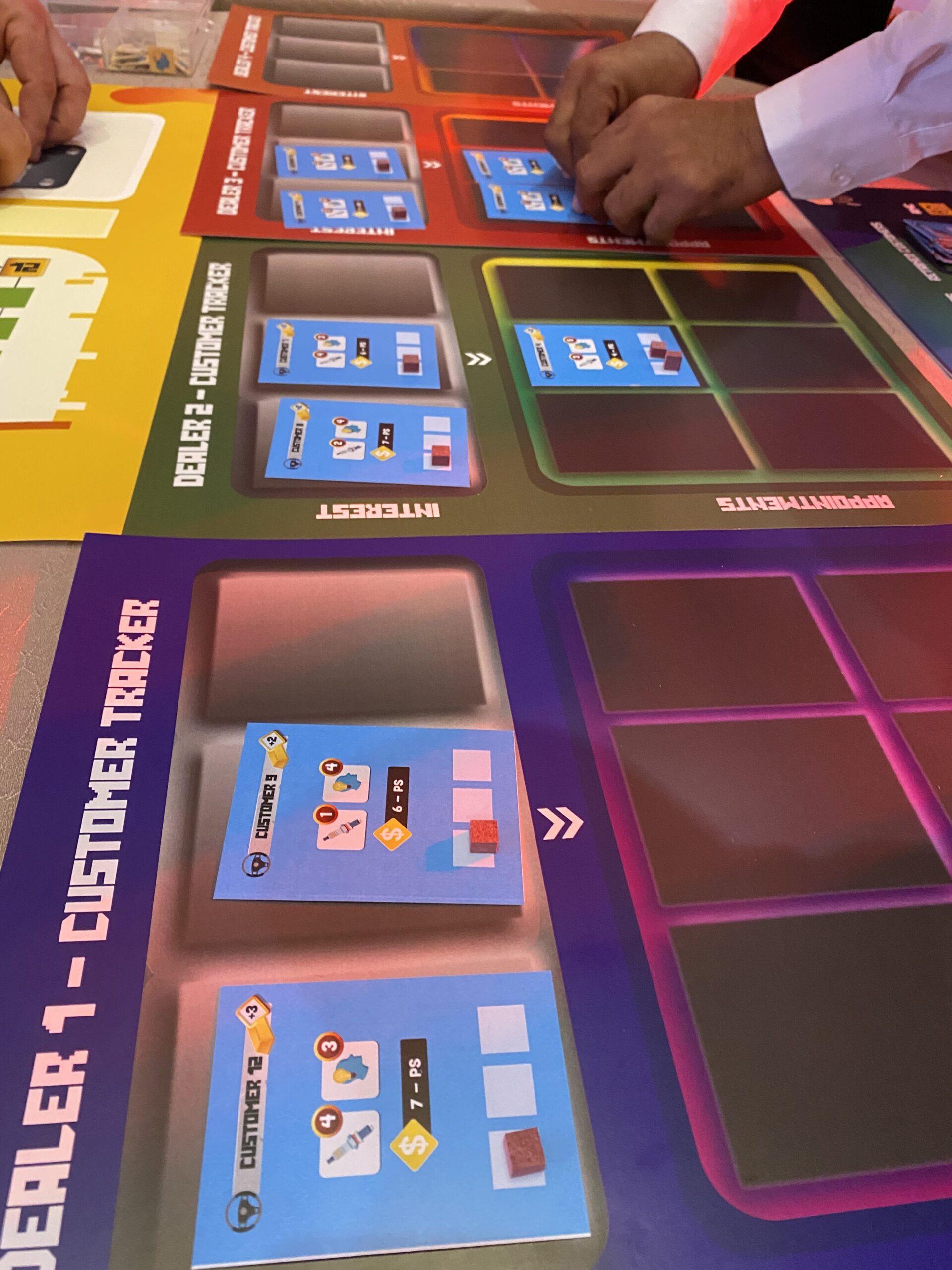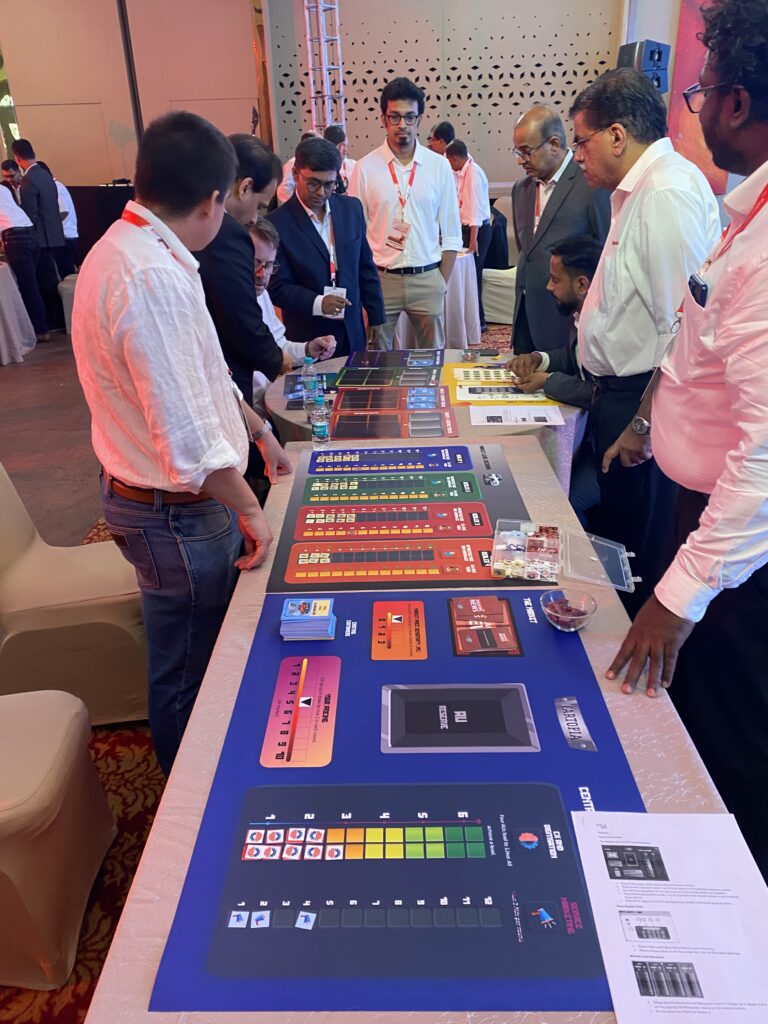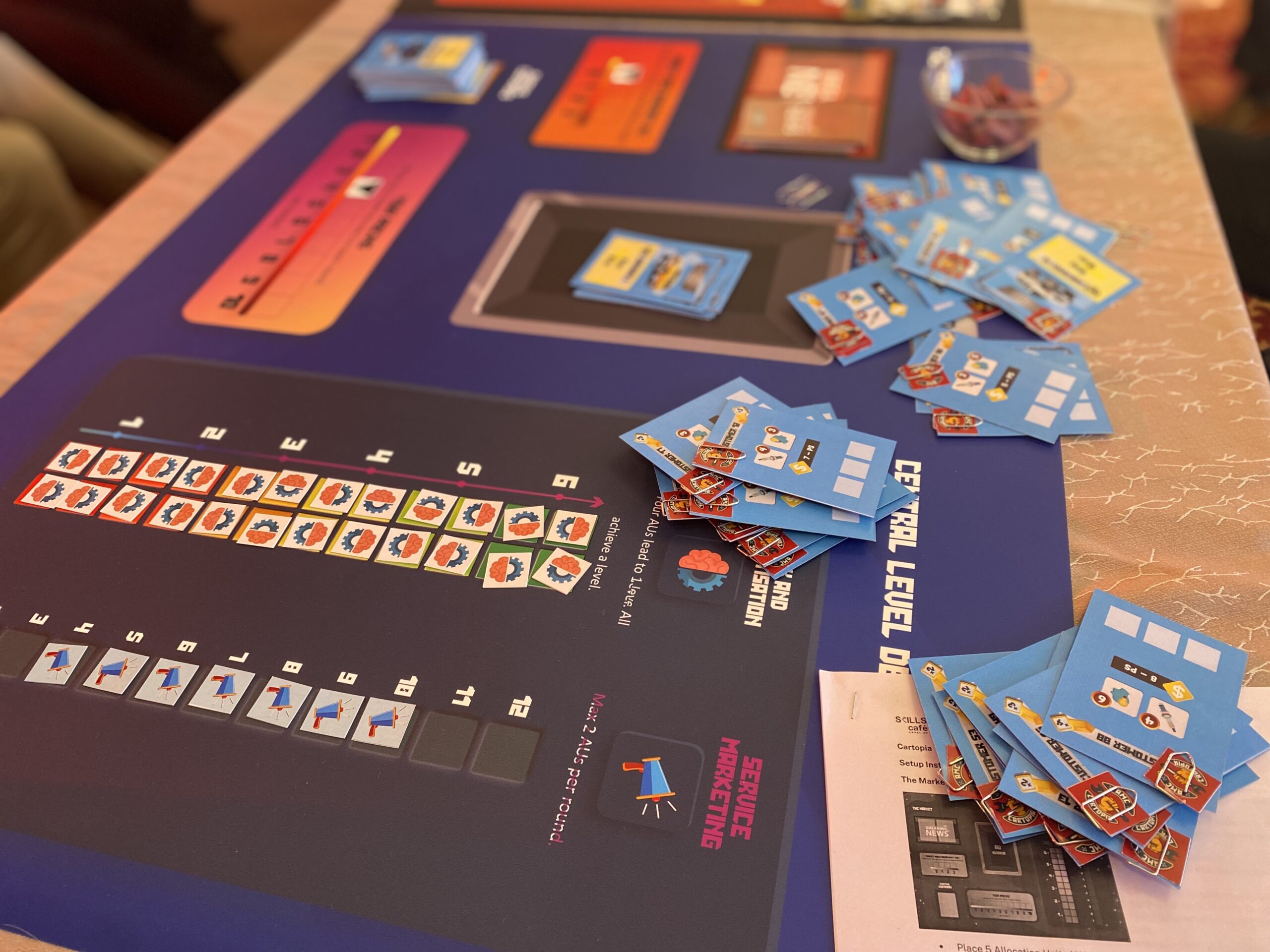Cartopia is a business simulation board game designed to provide players with an immersive experience in the complexities of the automotive industry. Players take on the role of decision-makers in a dynamic market, grappling with challenges related to customer service, parts supply chains, and strategic investments.
The game offers a rich learning environment, prompting participants to develop critical thinking skills, understand market dynamics, and hone their strategic planning abilities.
The game was designed and built by Skills Cafe’ in close collaboration with one of the largest car manufacturers in India.
Learning Objectives:
● Strategic Resource Allocation: Players learn to allocate limited Allocation Units (AUs) effectively across different areas like CX, service marketing, parts, infrastructure, and EW/AMC to optimize performance.
● Supply Chain Management: Players gain an understanding of supply chain dynamics by managing parts flow, considering lead times, and adapting to disruptions.
● Customer Acquisition and Retention: Players develop strategies to attract and retain customers by setting prices, meeting customer needs, and providing excellent service.
● Responding to Market Dynamics: Players learn to adapt to changing market conditions, including price sensitivity and breaking news events, to maintain competitiveness.
● Balancing Short-Term and Long-Term Goals: Players make decisions that balance immediate gains with long-term investments, such as investing in CX for sustained growth.

Board Setup
Here is how the boardgame us setup:
- Allocation Units (AUs): The foundation of decision-making in Cartopia rests on Allocation Units (AUs). Initially, 5 AUs are placed in the AU Reserve, representing the resources available to players for making various strategic decisions.
- Customer Base: A deck of cards numbered from 1 to 119 represents potential customers in the existing market. These cards are placed face down, symbolizing the unknown preferences and demands of the customer base.
- Market Sensitivity: A crucial element influencing customer behavior is Price Sensitivity, which is initially set at 0. This setting can fluctuate throughout the game, impacting customer responses to pricing strategies.
- Breaking News: The automotive market is constantly evolving, and Cartopia incorporates this dynamism through Breaking News cards. These cards, numbered from 1 to 10, are placed face down and revealed one by one during each round, introducing unexpected events that can disrupt market conditions and demand players’ strategic adaptation.
- Customer Experience (CX) and Digitization: Recognizing the growing importance of digitalization in the automotive sector, Cartopia features a CX and Digitization graph. Initially set at level 2, this graph reflects the company’s proficiency in providing positive customer experiences and leveraging digital tools.
- Parts Supply Chain: The backbone of any automotive business is the efficient flow of parts. Players start with an inventory of 3 Red and 3 Blue Parts tokens, representing essential components for vehicle servicing. To simulate real-world supply chain dynamics, a Pause token is placed on the Blue parts pathway; indicating a potential delay in acquiring those parts.
- Dealer Network: The game features a network of four dealerships, each with varying levels of infrastructure and manpower. Players must strategically allocate resources to optimize each dealership’s performance. Dealers 1, 2, and 3 start with pre-set infrastructure and manpower levels. Dealer 4 remains inactive initially, offering an opportunity for strategic expansion.
The Gameplay Strategy
The gameplay in the Cartopia business simulation board game is thoughtfully designed around two key phases. These phases mirror real-world business challenges. Let’s understand each separately.
Phase 1: Allocation Decisions
This phase focuses on strategic planning and resource allocation. Players carefully analyze market conditions, customer demands, and supply chain dynamics to make informed decisions. The following steps outline the key actions in this phase:
- Breaking News Unveiled: A new Breaking News card is revealed at the beginning of each round; potentially altering market conditions and prompting players to adjust their strategies.
- Pricing Strategy: Players determine the price of their products or services for the round. They can adjust the price within a limited range, considering market sensitivity and competitor actions.
- Strategic Allocation of AUs: Players utilize their AUs to invest in various areas, aiming to maximize their impact on customer acquisition, service quality, and overall business performance.
- Customer Experience (CX): Allocating AUs to CX enhances the company’s ability to provide exceptional customer experiences. This leads to increased customer loyalty and positive word-of-mouth referrals.
- Service Marketing: Investments in Service Marketing help attract new customers and build brand awareness.
- Parts Inventory: AUs are crucial for ordering essential parts ensuring a steady supply to meet customer demands. The number of AUs needed for each part type depends on the current Parts Supply (PS) situation.
- Infrastructure and Manpower (I&M): Investing in I&M at each dealership improves its capacity to serve customers effectively. These investments accumulate over the rounds, indicating long-term improvements in service capabilities.
- Extended Warranty/Annual Maintenance Contract (EW/AMC) Push: Allocating AUs to EW/AMC Push initiatives encourages customers to opt for extended warranties or maintenance contracts. Thus generating additional revenue and strengthening customer relationships.
- Strategic Expansion: Players can activate Dealership 4 or establish a Spare Parts Retailer by allocating the required AUs. This step open up new growth avenues and revenue generation.

Phase 2: Serving Customers and Spare Parts Retailers
This phase centers on operational execution, translating strategic decisions into tangible results. Players must manage their resources effectively, and service capabilities to meet customer demands and ensure business sustainability.
- Customer Acquisition: The number of potential customers drawn in each round depends on the company’s CX level and Service Marketing investments.
- Customer Assignment: Players strategically assign acquired customers to different dealerships based on each dealership’s capacity and the customer’s preferred location.
- Meeting Customer Needs: Players must fulfill specific price and parts requirements of each customer to successfully convert them into retained customers. Failure to meet these needs results in lost customers.
- Managing Parts Inventory: The parts required to service customers must be available in the inventory. If parts are not readily available, customers may have to wait, potentially leading to dissatisfaction.
- Ensuring Manpower Capacity: Each dealership must have sufficient manpower to service the assigned customers promptly and efficiently.
- Retaining Customers: Successfully fulfilling customer needs within a specified timeframe leads to customer retention, contributing to long-term business growth.
- Leveraging EW/AMC Opportunities: Players can capitalize on opportunities to sell EW/AMC packages to retained customers, further enhancing revenue generation and customer loyalty.
- Serving Spare Parts Retailers: If a Spare Parts Retailer is established, players must consistently supply them with the required number of parts to maintain the retailer’s operations.
How to Score Points and Win in the Cartopia Board Game
Success in the Cartopia board game depends on the strategic decision-making skills of each team. The team with the highest score after 12 rounds wins the game based on the following:
- Retained Customers: Each retained customer without EW/AMC contributes 1 point, while customers with EW/AMC contribute 2 points, highlighting the value of upselling strategies.
- Successful Spare Parts Retailer Operation: Maintaining a Spare Parts Retailer for at least 4 rounds while meeting the minimum parts supply criteria earns points based on the number of lost customers, reflecting the importance of supply chain management and strategic partnerships.
Transformative Insights: Key Learnings From Cartopia Business Simulation Board Game
Playing Cartopia goes beyond game play and engagement – it equips players with invaluable skills for tackling real-life business challenges.
- Strategic Decision Making: Players must make informed decisions regarding pricing, resource allocation, and market expansion, learning to balance short-term gains with long-term sustainability.
- Customer-centricity: The game emphasizes the importance of understanding and meeting customer needs, highlighting the impact of customer experience, and service quality on business success.
- Supply Chain Management: Players gain insights into the complexities of managing a parts supply chain, learning to anticipate disruptions, optimize inventory levels, and ensure timely fulfillment of customer orders.
- Market Dynamics: The game exposes players to the ever-changing nature of the automotive market, requiring them to adapt to shifting customer preferences, competitive pressures, and unexpected events.
- Financial Acumen: Players develop an understanding of revenue generation, cost management, and profitability, learning to make financially sound decisions that drive business growth.
Cartopia was used to deliver a full-day business simulation game-led workshop for the after market sales and service team of one of the largest car manufaturer in India.
Instructional Designer | Learning & Development | M.A I/O Psychology

